[Tutorial] How to Do Keyword Research for SEO with Free Tools
This is a highly actionable, step-by-step tutorial on keyword research for SEO.
If you’re looking for:
- Concrete guidance on keyword research
- Step-by-step instructions
- Free SEO keyword research tools that actually work
- Pro tips
Then, this guide is for you. You will use it as a handbook every time you need to perform keyword research for SEO.
Follow the instructions in this guide, and you will end up with the highest-quality keywords for every piece of content you will ever write.

What is Keyword Research?
Keyword research is your answer to the million-dollar question: how to let your audiences find you organically?
Consumers use the internet to find solutions to problems. From anniversary gift ideas to the latest news to financial services, consumers look for a variety of information on the internet. And when they do, they use specific keywords or key phrases to search for information.
Keyword research focuses on identifying specific keywords consumers use to find products or services you offer. Using these keywords, you develop a strategy to create content that aligns with what your audiences are searching for. SEO and keyword research are inseparable.
You can find out more about how keyword research fits into overall SEO efforts by visiting our SEO beginner’s guide.
Why is Keyword Research Important?
Because a shocking 96.55% of webpages never attract any traffic from Google!

Keyword research achieves twin objectives. Firstly, it helps you find out what your audience is searching for. Usually, it’s not a product or a service. They’re looking for a solution to their problem.
With keyword research, you can identify the specific keywords they use and therefore, the specific problems your audience is trying to solve. The solution can come in many forms. It could be a blog article, a video, an eBook, or something else.
It’s your job to create content that solves their problem. On occasion (although not always), you can effectively pitch your product or service as a solution to their problem without coming across as sales-y or pushy.
In short, keyword research gives you an unprecedented insight into your audience’s psyche, including their needs, desires, problems, ideal solutions, and more.
Secondly, keyword research helps you match your content to the intent of the audience. By analyzing the keywords, you can determine whether they are looking for advice, information, analysis, or purchase assistance. You can then create high-quality content that gives them precisely what they’re seeking.
Types of Keywords
The types of keywords you use in your content have a huge bearing on its visibility and organic traffic. So, you must understand the differences between different types of keywords and choose the right kind when creating content.
Here’s a quick overview of different types of keywords:
1. Keyword Types by Popularity
Traditionally, SEO professionals and content creators have heavily focused on keyword popularity as the single most important metric for evaluating keywords. Although search volume remains relevant, its importance has decreased. Still, it matters, and you should be mindful of keyword search volumes.
Popular Keywords
These are the most popular keywords on any topic. They have the highest search volumes and therefore, offer the highest potential to attract organic traffic.
However, they’re also targeted by the vast majority of competitors in your industry. In other words, they’re difficult to rank for. Keywords like “sneakers,” “smartphone”, “T-shirts,” etc. are examples of popular keywords.
So, unless you are an established brand with a strong digital presence, you will have a hard time ranking your content for those keywords. It can be done, but it takes a serious amount of SEO work. SEMrush has an insightful post on keyword difficulty if you’re interested.
If you chart a graph showcasing keywords and their search volumes, it looks something like this.
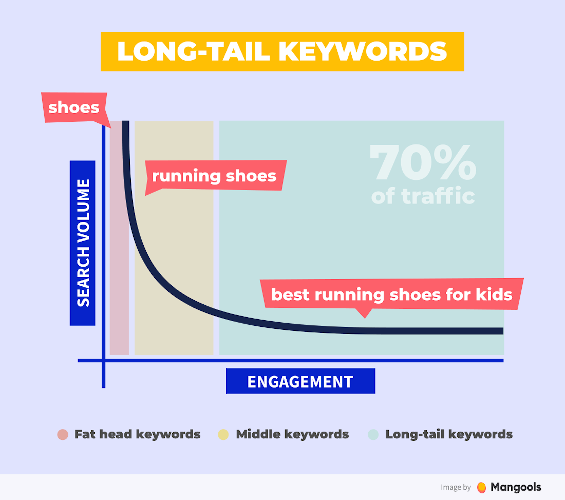
The keywords closest to the Y-axis have the highest search volumes, which taper out to the right. These are the popular keywords. They’re also called head-tail keywords because they appear at the beginning of the curve, i.e., the head of the tail.
Long-tail Keywords
Unlike popular keywords, long-tail keywords have low search volumes. So, not many competitors target them, which means they’re easier to rank for.
I’m talking about keywords like “where to find gym shoes for women,” “best comedy movies with 7 IMDB rating,” etc.
In the chart above, you can see the long-tail keywords appear towards the right edge, i.e., the longer tail region. Hence the name.
Although they have low search volumes, effective use of long-tail keywords can bring targeted and high-quality traffic to your website.
Medium-tail Keywords
These keywords fall smack in the middle of the graph. They’re not as popular as the top keywords, but still present some difficulty with ranking for them. After long-tail keywords, medium-tail keywords offer the highest growth potential for new websites.
2. Keyword Types by Match
The most common SEO keyword research tools throw up two types of keywords when you use them. Some of them may even let you filter out one of these.
Phrase Match
These keywords match the exact phrase (seed keyword) you used when generating the keywords list.
For instance, if you searched for “green shirts,” the phrase match keywords could be “green shirts for boys,” “green shirts for adults,” “bluish green shirts,” etc.
Your seed keyword appears in its exact form in the generated keywords. There could be other words added before or after the seed keyword, but never between the words of the seed key phrase.
Terms Match
Terms match keywords include all the words in your key phrase, but at random locations. The words in your key phrase may appear anywhere, in any order, in the keywords.
For instance, the seed key phrase “green shirts” may fetch terms match keywords like “shirts with green buttons,” “green T-shirts,” “green casual shirts,” “green collar shirts,” etc.
3. Keyword Types by Intent
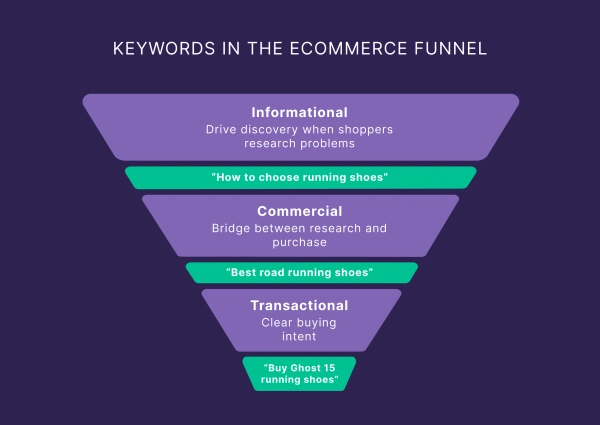
Keyword research is the first step to creating highly relevant content that attracts search engine users organically. However, you must attract the right kind of traffic. For instance, if they’ve made up their mind and are looking to make a purchase, they should be directed to your product page and not to your case studies.
You can achieve this by matching your content to keyword intent. Here are four types of keywords based on intent:
Informational Intent
Searchers are looking to educate themselves on the topic and define their problem. At this stage, they use keywords like “birthday party ideas” or “smartphones with facial recognition feature”
Commercial Intent
Once the consumers have a general idea of what their solution looks like, they now compare and evaluate the various solutions in the market. They find this info using keywords like “top budget DSLR cameras,” “nike running shoes reviews,” etc.
Navigational Intent
They’ve identified the specific solution they intend to use and now need the search engine’s help to find it. They use straightforward keywords like “wikipedia”, “amazon,” “magicdart,” etc. to find what they’re looking for.
Transactional Intent
The searchers are now at the final stage of their search. They’ve honed in on the solution and are looking to get it. Using keywords like “buy iPad 11th gen,” “book flights to new york,” “pizza hut near me,” and so on, they’ll quickly find what they’re looking for and end their search.
4. Other Keyword Types
Thanks to changes in search engine algorithms in recent years, they’ve become increasingly effective in matching user search relevance to content. They do not rely solely on traditional keywords and keyword types to rank content in searches.
Other types of keywords have emerged and acquired greater significance for SEO purposes. Here are a few of them:
Google Autocomplete Keywords

When you type something in Google, it automatically gives you multiple keyword suggestions as you type. These suggestions are a goldmine of relevant keywords. They tell you what others are looking for.
They give you direct insights into your audience’s needs, although you don’t get any idea of their popularity. For that, you need to use a keyword research tool like Google Keyword Planner.
Related Searches on Google
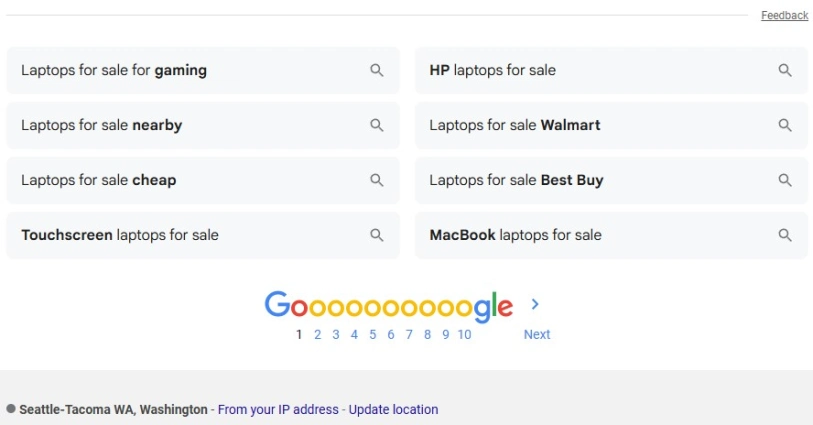
Once you’ve performed a search on Google, scroll down to the bottom of the page, past the search results, and you’ll find a list of “Related searches.” Google thinks that these keywords are closely related to your search topic. So, they’re highly valuable too.
Semantic Keywords
Latent Semantic Indexing (LSI) keywords have been part of Google’s ranking priority for over two decades now. Unlike closely matching keywords, semantic keywords are related to your seed keyword only by theme or topic. Often, they’re not even a broad match.
This is best explained with an example. So, let’s say you’re writing an article on Mars.
If you’re writing about Mars, the planet, in the astronomy context, some of the subtopics you’ll discuss in the article could be: red planet, solar system, Olympus Mons, Perseverance rover, Phobos, water on Mars, etc. These words or phrases are only related to Mars by theme. When you use these words in the article, Google knows that you’re talking about Mars in the astronomy context.
However, suppose the keywords you use in the article include Ares, the Roman God of War, mythology, Campus Martius, Arval Brothers, etc. In that case, Google determines that you’re talking about Mars in the context of Greek mythology.
Such related keywords help Google understand the context of the topic better. They are called LSI keywords, and they’re vital to your search engine popularity.
How to Find Keywords
Congrats. You now have a firm grip on different types of keywords. It’s time to learn how to find them.
You could start with a powerful SEO tool like SEMrush, Ahrefs, Moz Pro, AnswerThePublic, KWFinder by Mangools, or others. However, I recommend that you go with free tools for now. Experiment with different tools and keyword types, create content using them, track results, and get a sense of what works and what doesn’t.
Once you develop a better understanding of keyword research, graduate to a premium tool. Many premium tools offer limited-time trials to help you get acquainted with them. You can test their advanced features and appreciate them better once you understand the intricacies of keyword research.
1. Use Google Keyword Planner for Basic and Competitor Keyword Research
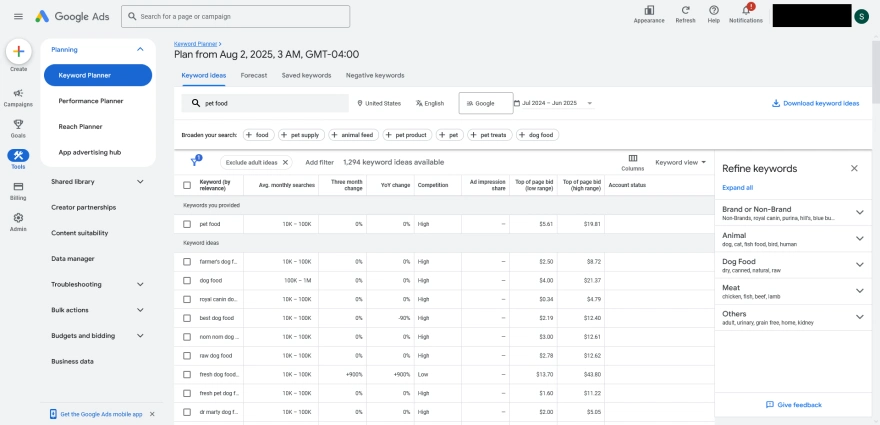
Since your SEO efforts are primarily focused on Google, it makes sense to go to the source for information on keywords, right?
Google has a pretty nifty tool to help marketers find relevant keywords: Google Keyword Planner. It is not a standalone tool but is available as part of the Google Ads toolkit. You can log in using your Google account for quick access to the tool.
It’s easy to use and generates fairly detailed keyword data, rich with monthly search volumes, keyword difficulty, and other details. Since it’s designed for Google Ad users, you’ll also notice bid data. You can ignore that for now.
You can make the most of your keyword research if you have a keyword idea or two to begin with. If you don’t, that’s fine too. Google Keyword Planner lets you pull keywords directly from your competitors’ websites and perform keyword research.
2. Go With Wordstream’s Free Keyword Tool for Quick and Easy Keyword Research
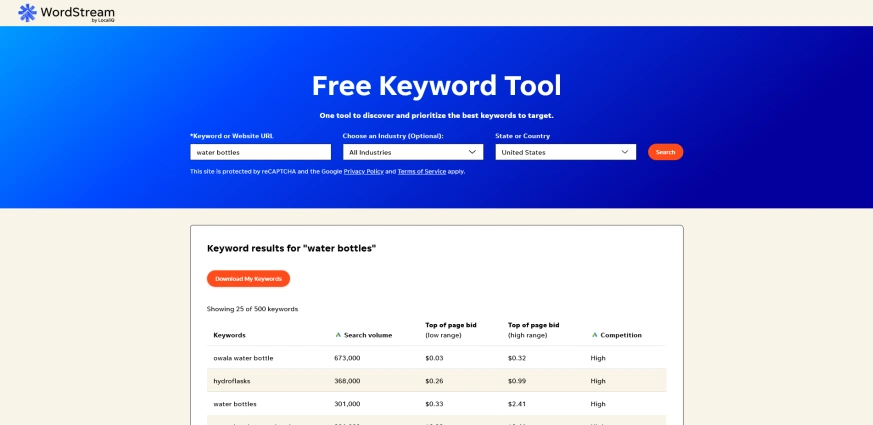
Wordstream’s Free Keyword Tool offers one of the most convenient and powerful keyword research tools. It sources keyword data directly from Google and Bing, so you know it’s highly reliable.
Think of Free Keyword Tool as a watered-down version of Google Keyword Planner. Although it lacks some advanced features, it makes keyword research faster for you.
With every search, you can fetch popular, medium-tail, and long-tail keywords, all at once. The keywords are accompanied by search volumes and competition index (keyword difficulty) to help you pick keywords with less competition.
There’s no signup required to access this free keyword research tool for generating the keywords, but you may be asked to share your email address for downloading the keywords data.
3. Use WriterZen Keyword Explorer for Professional Topic and Keyword Research
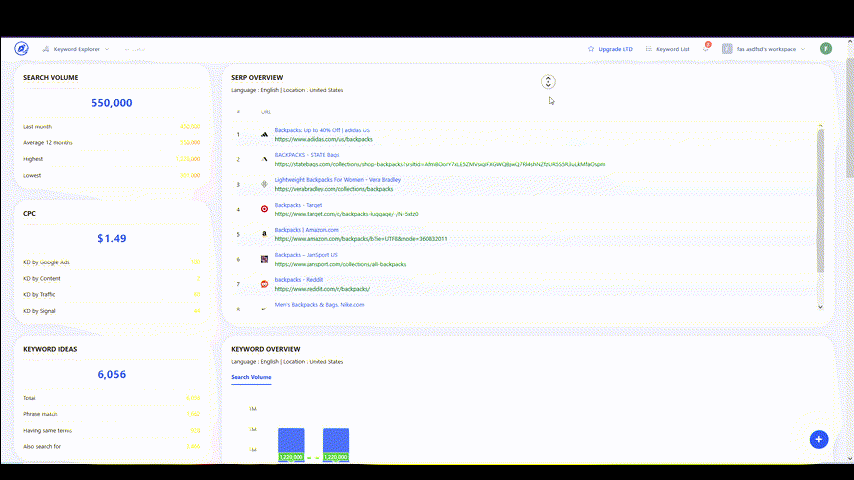
WriterZen Keyword Explorer is one of the best free keyword research tools we’ve come across in recent years. It’s powerful and comprehensive!
WriterZen Keyword Explorer excels at everything from keyword research to topic discovery to keyword planning. Its various features may be a bit advanced for beginner SEOs, so you should narrow your focus on keyword research for now. It has a relatively steep learning curve, but it makes up for it with comprehensive analyses and reports.
Although WriterZen Keyword Explorer is free, it comes with usage limits that aren’t particularly generous but not stifling either. That said, WriterZen offers incredibly affordable lifetime subscriptions.
4. Try Uberuggest for High-level Keyword Research Only
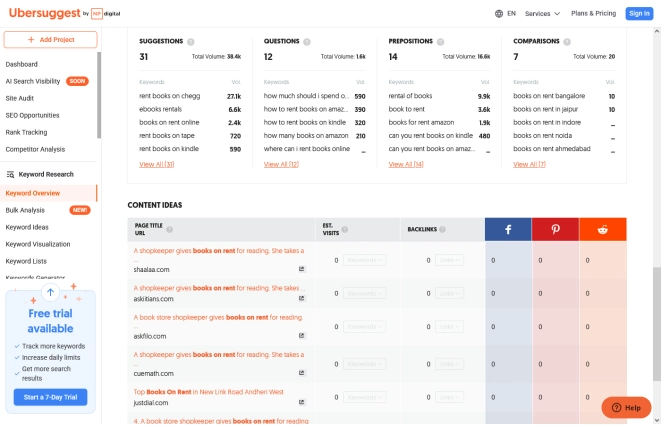
Ubersuggest is a free keyword research tool from Neil Patel, a renowned name in SEO. Free users get limited searches per day, but it’s usually good enough for beginner SEOs who don’t perform dozens of searches each day.
Although its data is not the most accurate, Ubersuggest makes up for it by providing you with a comprehensive perspective on your keyword research. Its reports include search volumes, competition, backlinks, social search volumes, content ideas, and more.
Besides a free trial, Ubersuggest offers monthly plans and lifetime plans, too, although they’re more expensive than WriterZen’s.
5. Check Google Trends for Viral Topics and Keyword Research
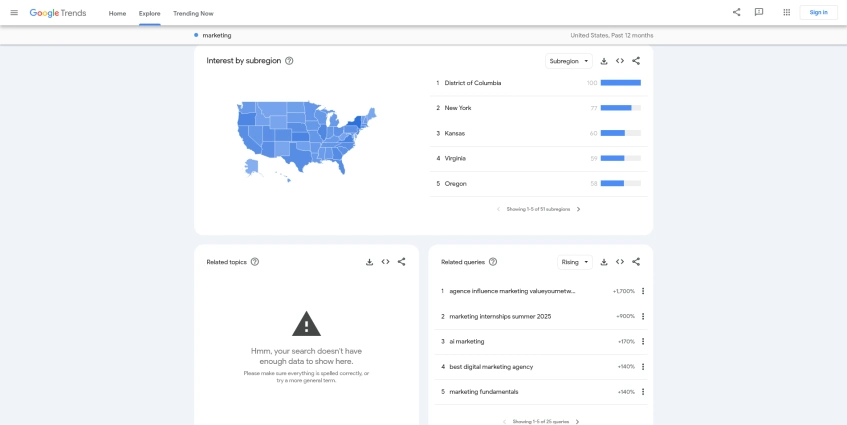
Disclaimer: Google Trends is not designed to be used as a standalone keyword research tool.
However, it’s the perfect tool for identifying key trends in the making before they explode. Therefore, it can be a good starting point for discovering primary keywords to kickstart your keyword research. You can then use the keywords or topics you discover here as seed keywords to perform in-depth keyword research.
6. Gather Related Keywords from Google Search
As I mentioned earlier, Google Suggest (autocomplete suggestions) is a brilliant way to find out what your audience is searching for.
Head over to Google Search and use your seed keyword to discover medium-tail and long-tail keywords. You can even restructure your seed keyword or use different versions of it to gather more related searches.
This will help you develop deep insights into your audience’s search behavior, and discover some high-quality keywords in the process.
Likewise, the “Related searches” section at the bottom of the search page helps you find other high-quality variations of your seed keyword. Do not ignore these two sources.
7. Make Use of YouTube’s Search Engine for Long-tail Keyword Research
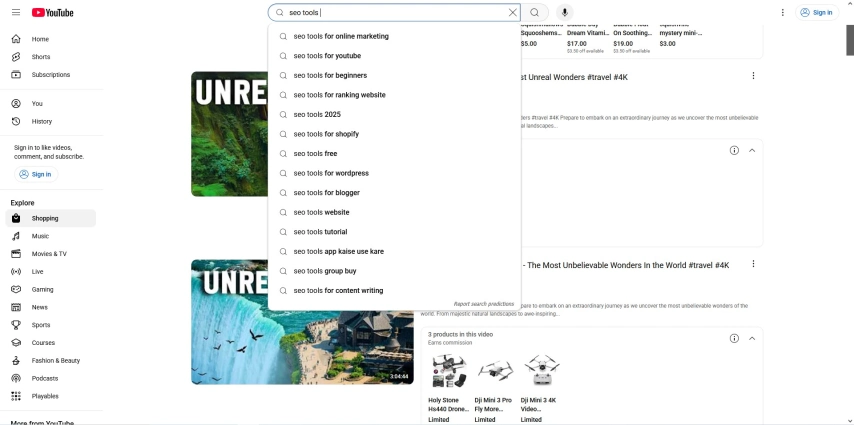
What many marketers do not realize is that YouTube isn’t just a content platform. It’s a search platform too. In fact, it’s the second-biggest search engine in the world, second only to Google. It’s bombarded with billions of searches by users worldwide, looking for everything from entertainment to solutions to advice.
Go to YouTube and start typing your seed keyword. You’ll get autocomplete suggestions, just like on Google Search. Those are the popular queries related to your seed keyword. Depending on the type of content you’re creating, they could help you pull highly targeted traffic to your content.
How To Do Competitor Research?
Remember how I mentioned earlier that premium SEO tools offer advanced keyword research features? Competitor research is one of them.
Many of those tools give you in-depth insights into the competition – keywords they’re targeting, their best-performing keywords, keyword-specific traffic, best-performing pages, average ranking positions, and so on.
But you don’t need those tools to get started with competitor research. You can do it manually, albeit in a limited way.
When you wish to rank for a specific keyword, use it to perform a Google search. Now, check out the top-performing websites for that keyword, and find out where you currently rank for that keyword.
Now, ask yourself this question: How big are those top-ranking pages compared to you?
If their budgets, team size, and other resources are many times bigger than yours, it means that you will have a hard time beating them for that keyword. So, look for medium- to long-tail keywords where the top performers are relatively small. With some consistent efforts, you could beat them.
It’s a crude way to perform competitor research, but it should work when you’re getting started.
How to Analyze Keywords
In the previous step, you generated dozens of keywords, if not hundreds of them. Now, it’s time to filter and finalize the most useful, relevant, and effective keywords from your lists for creating content. But, how do you decide which of them are right? That’s where SEO keyword analysis comes into play. You analyze keywords based on various factors and metrics to filter the most relevant and useful set for your needs.
Step 1: Pick Keywords Based on Difficulty

Most keyword research tools share the “difficulty” metric to indicate how difficult it is to rank for a specific keyword. Always choose keywords with lower difficulty, even when you’re choosing medium-tail keywords.
Long-tail keywords usually do not have high difficulty values.
Step 2: Shortlist Keywords Based on Search Volume

If you recall our discussion from the section on keyword types, you’d remember not to pick the most popular keywords. Usually, your choice should be between medium-tail and long-tail keywords.
If you launched your website recently, stick to long-tail keywords for now. They’ll help you rank for highly specific keywords better.
On the other hand, if you already have a decent web presence with a good backlink profile, choose 1 medium-tail keyword and multiple long-tail keywords per topic or page.
Step 3: Verify Search Relevance and Intent
Take a moment to consider whether the keywords you’re choosing will allow you to create highly relevant content that perfectly matches the search intent of the user.
For instance, if you’re researching keywords to create product pages, choose transactional keywords.

Likewise, for blog posts, choose informational keywords.
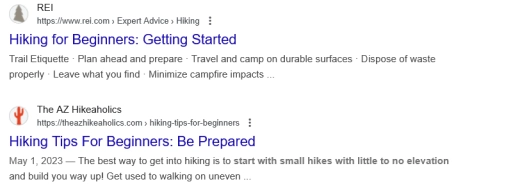
And that’s not all. Make sure the content you create fully satisfies the searcher’s need. The user should not be forced to hop onto another website to find missing information in your content.
Step 4: Create Keyword Clusters
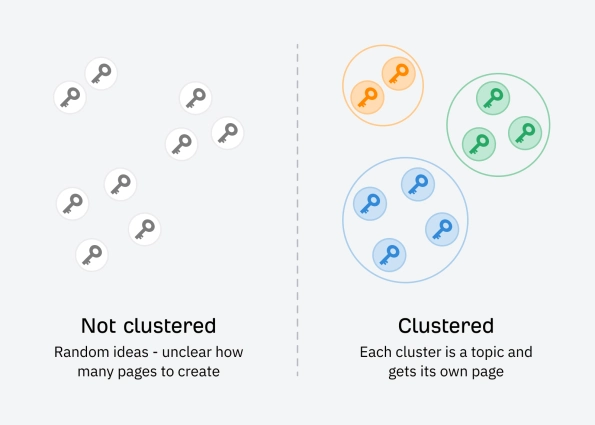
A typical keyword cluster should include the following:
- 1 primary keyword
- Multiple secondary keywords (long-tail keywords)
- Related keywords (some of them can be used as variants of the primary keyword)
- LSI keywords are hyper-focused on the topic of the primary keyword
Each keyword cluster would then be used to create a unique piece of content.
Step 5 (Optional): Track Keyword Performance
If your website is connected to Google Search Console, it will give you detailed reports on keyword performance, page-wise traffic, and other data. And while at it, sign up for Google Analytics too. It’s a more powerful and comprehensive tool with detailed traffic reports.
By continuously monitoring your website performance, you can fine-tune your keyword strategy as you go.
How to Use Keywords?
Once you’ve developed keyword clusters, it’s time to create content.
Generate content ideas that perfectly match the search intent of each keyword. You can brainstorm ideas, check out competitor websites for inspiration, use tools like WriterZen, UberSuggest, BuzzSumo, and others to come up with content ideas.
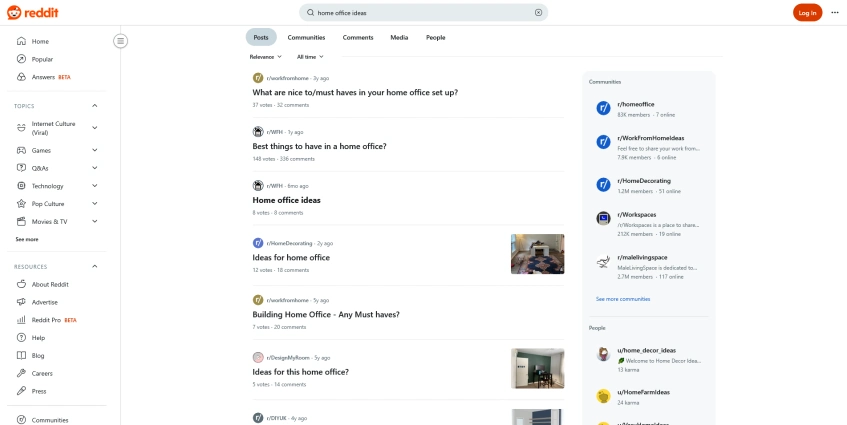
You can visit platforms like Reddit, Quora, YouTube, and other forums to discover common problems users face and the solutions that best meet their needs. You can learn more about how SEO and keyword research fit into the larger content marketing strategy on our service page.
It’s now time to use the keywords you’ve generated and the content ideas you’ve collected from various sources to create high-quality content that meets your audience’s needs.
Check out our detailed on-page SEO guide for a detailed checklist on how to use keywords to create SEO-friendly content that pulls traffic.
Wrap-up
Modern SEO best practices go beyond keywords. Nevertheless, keywords form the core of every SEO strategy. They’re indispensable. So, use them cleverly to grow your business organically.
Did you learn something useful from this guide? Drop a comment below with your feedback.
Constructive criticism is always welcome. And if you’d like to learn about something specific, feel free to mention it in the comments.
You can learn more about our approach to SEO on our service page.
For a free consultation on how we can fuel your digital growth with a robust keyword strategy and SEO in general, or get in touch.

Leave a Reply